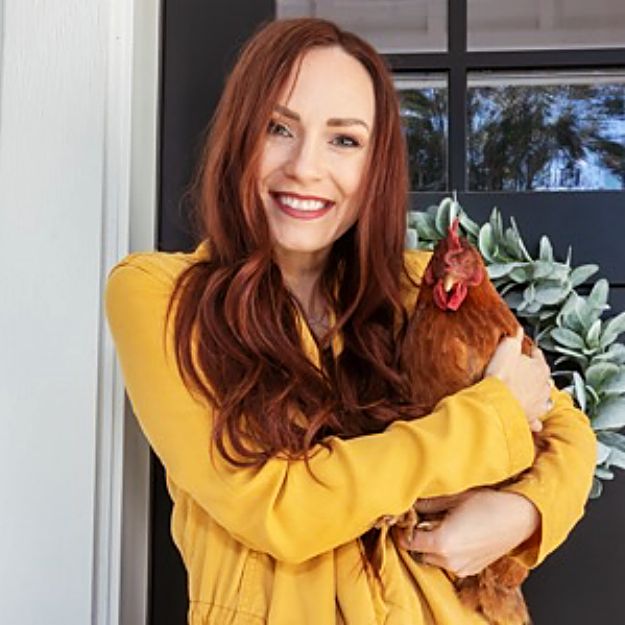How do chicken eggs get fertilized? What does a red spot inside the egg mean? Let’s dispel some myths and misperceptions! Most people have a very limited understanding of what eggs are and how chickens make them. Here are 12 facts and myths about eggs!
(For people trying to hatch their own eggs, it’s especially important to understand how eggs get fertilized and how they develop—for the best possible chance of producing adorable, fluffy chicks.)
Facts About Eggs (Debunking Myths!)
1. Eggs Are Not Chicks
To get the most common misperception out of the way first, eggs are not baby chicks, and not every egg can develop into a chicken.
Instead, eggs are like a house for a baby chick to grow up in; fertilization is the process that puts a chick in the house. Fertilization only happens when a hen and a rooster mate; most hens lay eggs every few days regardless of whether they’ve mated or not. Learn how many eggs chickens lay.

2. Store Eggs Are NEVER Fertilized
This is probably the most common misconception about chicken eggs. Commercial layers are never allowed to mate with roosters—most commercial farms don’t even have any roosters on the premises—so it’s impossible for the eggs they produce to be fertilized. This means the vast majority of eggs consumed in the US every day are not and never were going to be baby chicks. Grocery store eggs are not fertile—not even “free range” or “organic” eggs.
3. A Red Spot is NOT an Embryo
Blood on the yolk has NOTHING to do with fertility. This is a common misconception about eggs and leads some people to avoid perfectly good eggs. That spot of blood is technically called a “meat spot,” but it isn’t the meat of a chicken fetus. It’s the result of a blood vessel rupturing in the hen’s oviduct as she passed the egg but it has no effect on the flavor or safety of the egg. Again, a spot of blood has nothing to do with egg fertilization.

4. Egg Yolks Do NOT Become Chicks
Egg yolks are NOT embryos and don’t develop into baby chicks. Part of the confusion around whether or not eggs are fertilized may come from people not understanding how an egg works. The two different fluids found in an egg—the yellow yolk and the clear white or albumen—serve different purposes in nurturing a developing embryo, but neither of them has the potential to turn into a chick.
The yolk is the energy source an embryo would use to fuel its development. The white also provides some energy, but it’s 90% water, and its main purpose is to protect the developing chick. The yolk is more flavorful and higher in fat than the white, but the white contains more than half of the protein found in an egg.
5. The Egg Whites Are NOT A Sign of Fertility
This is another common misconception. That stringy white stuff is called a “chalaza,” and it’s a bit like egg scaffolding. It is not an embryo or a sign of fertility. Rather, it holds the yolk in place within the egg so that it stays suspended in the white without bashing up against the shell. You can use the chalazae to tell how fresh an egg is; they tend to thin out as the egg gets older and will be thickest in the freshest eggs.
5. Eggs Are Laid WITHOUT Roosters
Hens lay eggs without having ever had sex with a rooster. This is how most hens in the world lay their eggs. This might seem like a waste of energy from an evolutionary or biological perspective, and it is. Humans have selectively bred hens to produce more and more eggs, regardless of fertilization, which is only possible because farmers provide the birds with far more nutrition and energy than they would get in the wild. See our article on how chickens mate.

7. One Mating = 2 Weeks of Fertile Eggs!
Hens do not lay fertile eggs until 10 to 14 days after having had sex. This is the approximate amount of time it takes for the rooster’s sperm to travel up the hen’s oviduct to the ovary, where egg cells are waiting to be fertilized.
But it’s worth the wait! After sex, hens can store sperm in their bodies to fertilize further eggs. After the initial week or two of waiting for fertile eggs, hens can continue to lay fertile eggs for another week or two, just from that one mating session.
8. A Rooster Doesn’t Guarantee Chicks
Even after she mates, not all eggs that a hen lays will be fertile. Only about 60% of successful mating results in fertilization. There may be many reasons for this, not all of which are fully understood. Also, some roosters are just not fertile.
However, if you think about how complicated the process of creating new life is, it makes sense that chickens can’t do it perfectly all of the time.
9. There is NO Way to Tell if an Egg is Fertile
There is no way to tell if a fresh egg is fertile—without cracking it. When it’s fresh, a fertilized egg is indistinguishable from an unfertilized one, except for a small bullseye shape on the yolk. This is the cluster of cells with the potential to grow into a chick, but it’s too small to be seen from the outside. If you’re looking to hatch your eggs, you’ll have to gamble on which ones are fertilized. Some keepers recommend “testing” some eggs in a batch by cracking them open, with the assumption being that if those eggs are fertile, the other ones will be, too.
However, after an egg has been in an incubator for about one week, you can use a technique called “candling” to shine a light (in a dark room) through an eggshell to see the blood vessels and structures developing inside. The name comes from the old method in which people actually used a candle; nowadays, most chicken keepers just use a flashlight. Most keepers candle their eggs once or twice early in the incubation process to check that everything is developing properly; removing eggs from the incubator more often can decrease their chances of survival.

10. Fertile eggs can be hatched either in an incubator or under a hen.
If you have a broody hen, getting her to sit on fertilized eggs can greatly reduce your workload. If you don’t, or you simply don’t want to trust the process to the coop, you can use an incubator to keep the eggs warm. This will require turning the eggs frequently for most of their 3-week incubation period, and you will also have to raise the chicks you hatch yourself. Of course, this might be necessary either way, as even broody hens sometimes make terrible mothers.
11. A Fertilized Egg Does Not Always Mean a Chick
Don’t count your chickens before they hatch! There is no guarantee that even a fertile egg will develop into a healthy chick. Creating a chicken is complicated, and even the finely honed natural process gets it wrong sometimes. One of the benefits of candling is that it allows you to remove infertile eggs or eggs that have stopped developing properly. Nonviable eggs won’t look the same as their siblings when they’re candled; most commonly, they’ll exhibit a blood ring, a dark circle made of the free-floating blood vessels that have started to decompose. These eggs should be removed from the incubator quickly, as continued exposure to the heat can make them explode, endangering your other eggs.
12. Fertilized Eggs Have Same Taste as Unfertilized
This is our final myth. There is no difference in flavor or texture between fertilized eggs and unfertilized eggs. In addition, there is no difference in nutrition. The chemical differences are so miniscule that the fact that the egg was fertilized can not be detected.
Did any of these facts surprise or inform you? There is a lot of misinformation and ignorance out there about egg fertilization and fertilized eggs. Luckily, the average consumer and even many chicken keepers don’t have to worry about it and can rest easy knowing they have probably never come into contact with a fertilized egg.
Interested in raising chickens? See our article on how to care for baby chicks.















Comments